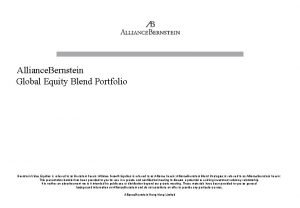CISI Financial Products Markets Services Topic Equities 4












- Slides: 12

CISI – Financial Products, Markets & Services Topic – Equities (4. 1. 5 and 4. 1. 6) Corporate Actions cisi. org

Corporate Actions What is a Corporate Action? Where a company does something that affects it’s investors e. g. Shareholders These actions are generally agreed upon by the board of directors before being authorised by shareholders What are the main categories of Corporate actions? These classifications are used across Europe and by Euroclear and Clearstream (Both International Central Securities Depositories Mandatory Investor has NO CHOICE Obligatory – mandated by the company DOES NOT require any intervention from investors Mandatory with options Voluntary Investor has an ELEMENT OF CHOICE Investor has a DEFINITE CHOICE to make A DEFAULT OPTION is given to shareholders if they choose not to intervene by a particular date A DECISION MUST be made to choose between OPTIONS presented to them cisi. org

Securities Ratios Before we take a closer look at different examples of corporate actions, you need to know how corporate actions are expressed to investors. This is known as a securities ratio and it stipulates the terms of a corporate action (What the shareholder should expect from the company) It can be expressed in different ways depending on the type of corporate action: Nature of corporate action Terms expressed as. . . Dividends paid Amount of dividends paid per share (£) Giving new shares to existing A ratio of the number of new shares received as a shareholders proportion of the number of shares owned. e. g. 1: 4 (X new shares for each ‘Y’existing shares) This method is used in Europe and Asia In the USA the ratio is expressed differently: The first number in the ratio states final holding after the event; the second number is the original number of shares held. e. g. If the securities ratio is 5: 4 and an investor holds 1, 000 shares, after the event, the investor now owns 1250 shares compared with the 1000 they owned originally i. e. 1250: 1000 cisi. org

Examples of a Corporate Action – Rights Issue A company wants to raise finance: To expand To repay bank loans To repay bond finance An existing shareholder has pre-emptive rights to buy shares so that their proportionate holding is not diluted. Rights Issue Offer of new shares to existing shareholders (“Cash Call”) Shareholders Can react positively or negatively to the rights issue What can they do? Shares are normally offered to existing shareholders at a discount to market price The initial response to the announcement of a planned rights issue will reflect the market’s view of the scheme. Share prices can RISE or FALL as a result Mandatory with options Take up the rights – buy the shares Sell the rights to another investor (often transferrable – known as ‘renounceable’) Do Nothing (Default option used) Sell sufficient rights to raise the cash to take up the rest cisi. org

Examples of a Corporate Action – Rights Issue Completed Rights Issue Underwriters of a share issue agree, for a fee, to buy any portion of the issue not taken up in the market at the issue price. Shares They sell the shares they have bought when market conditions seem opportune to them (at a gain or a loss) The share price changes to reflect the effect of the rights issue once the shares go ex-rights (after the rights issue has happened) This is the point at which the shares and the rights are traded as two separate instruments This adjusted share price is known as theoretical ex-rights price (actual price will depend upon the interaction of buyers and sellers in the market at the time) In the case of Con Air plc, theoretical ex-rights price was £ 3. 77 The rights can be sold and the price for these rights is known as the premium. (theoretical ex-rights price - price of a new share) In the case of Con Air plc £ 3. 77 - £ 2. 00 = £ 1. 77 cisi. org

Examples of a Corporate Action – Bonus Issue Mandatory example securities ratio: Scrip AKA Bonus Issue AKA Capitalisation Issue 2: 1 2 new shares for every 1 existing A company gives existing shareholders additional shares without paying anything Lowers the company share price Increases liquidity of share – more buyers! Psychologically, a company’s share price can become too high and less attractive to investors UK Cos. Like a share price under £ 10 cisi. org

Examples of a Corporate Action – Dividends The part of a company’s profits passed to shareholders DIVIDENDS Interim Dividend First dividend declared by directors and paid halfway through the year Final Dividend Second dividend paid after approval by shareholders at the AGM, after the end of the financial year Many UK company’s pay them twice a year Dividends per share may vary according to § Overall company profitability § Plans for future expansion SHAREHOLDER S Mandatory Receive the dividends by: § Cheque or § Transfer straight into their bank accounts § Transfer via CREST (system) cisi. org

Examples of a Corporate Action – Receiving dividends When shares change hands, determining the correct person to receive dividends can be difficult Procedures have been put in place to prevent mistakes in paying dividends to the wrong person SHAREHOLDER S Shares are bought and sold with the right to receive the next declared dividend up to the date shortly before the dividend payment is made. Cum-dividend (with) If the shares are purchased cum-dividend, the purchaser will receive the declared dividend. Ex-dividend (without) At a certain point between the declaration date and the dividend payment date, the shares go ex-dividend. Buyers of shares are not entitled to the declared dividend. THURSDAY is Ex-Dividend day (Buying ex-dividend means shares fall in price by 8 p Standard settlement period across Europe is T+2 (A trade will be settled two business days after it is executed) cisi. org

Cum and Ex Dividend Example Holding plc calculates its interim profits (for the six months to 30 June) and decides to pay a dividend of 8 p per share. Holding plc announces (‘declares’) the dividend on 1 September and states that it will be due to those shareholders who are entered on the shareholders’ register on Friday 7 October (Record date, register date or books closed date). (The actual payment of the dividend will then be made to those shareholders at a later specified date. ) Given the record date of Friday 7 October, the LSE sets the ex-dividend date as Thursday 6 October. Ex-Dividend Date On this day, the shares will go ex-dividend and should fall in price by 8 p. This is because any new buyers of Holding plc’s shares will not be entitled to the dividend. The actual payment of the dividend will then be made to those shareholders on the register at the record date at a later specified date, say Wednesday 22 October. Record Date Register Date Books Closed Date cisi. org

Examples of a Corporate Action – Takeovers A company can grow organically or take a different route – buy other companies TAKEOVER Predator Company (company bidding to buy another) The predator company is under an obligation to report their share purchases once they reach a certain percentage Hostile Takeover Directors of the target company consider the offer not attractive. They recommend that their shareholders reject the offer. Voluntary Shareholders of the target company can choose whether to accept or reject the bid, a hostile takeover bid can still be successful Target Company (company bid for) Friendly Takeover Success = predator company “gains control” by buying more than 50% of the shares of the target company Directors of the target consider the takeover bid to be acceptable, and recommend acceptance to shareholders. cisi. org

Examples of a Corporate Action – Mergers MERGER Voluntary Company one Company two The two companies agree to merge their interests. In a merger it is usual for one company to exchange new shares for the shares of the other entity Forms 1 single large company cisi. org

Corporate Actions Overview Action taken by the company Description Category of corporate action Dividend payment Shareholders receive payments (normally twice a year) based on company profits Mandatory Bonus/Scrip/C The Board issues new shares to existing apitalisation shareholders for free, generally to increase liquidity issue of shares so that the share price falls. Mandatory Rights issue The Board issues new shares to existing shareholders (First option) at a discount their market price to raise finance Mandatory with options Merger Two companies agree to merge their interest to form one larger to company Voluntary Take-over A predator company bids for a target company and aims to buy the majority of shares in the target. A take-over can either be friendly (target shareholder approval) or hostile (target shareholder rejects) Voluntary cisi. org
 Cisi chartered wealth manager
Cisi chartered wealth manager Alliance
Alliance Equity meaning
Equity meaning Statistical arbitrage in the us equities market
Statistical arbitrage in the us equities market Cisi chartered wealth manager
Cisi chartered wealth manager Applied wealth management
Applied wealth management Millennium 3 financial services
Millennium 3 financial services Cisi introduction to securities and investment
Cisi introduction to securities and investment Cisi or cfa
Cisi or cfa Creating products for consumers in global markets
Creating products for consumers in global markets Why study financial institutions
Why study financial institutions Participants of money market
Participants of money market Classification of financial markets
Classification of financial markets























